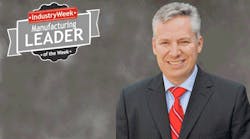Building Technology—and a Workforce—for the Long-Term at Schaeffler
What effect shifting political sands in the United States will have on vehicle electrification globally remains to be seen. There’s no shortage of innovation in that arena, however. In January, automakers and suppliers rolled out their electrification strategies and showcased their e-mobility solutions, from scooters to luxury vehicles, at the North American International Auto Show in Detroit.
The German precision engine parts maker Schaeffler was no exception, predicting that electrified vehicles will grow from 3% to 70% (30 battery electric/40 hybrid) of the global market by 2030. The company, which has five R&D centers in North America, showcased electric axles and a 48-volt on-board electric system built on a concept “mild hybrid” vehicle.
Marc McGrath, Schaeffler’s president of Automotive Americas, sees electrification as “an opportunity more than a threat,” with its applications for autonomy, connectivity and shared mobility. The way he interprets it, the 70% forecast, in addition to great growth in electric, also shows that automakers will be straddling conventional and electric powertrains for a long time. That 40% hybrid and 30% gas-powered still adds up to a lot of conventional.
McGrath, has been in his current position since 2016 but all told has spent 29 years in Wooster, Ohio, at Schaeffler USA and its subsidiary Luk, now part of Schaeffler proper. He started his career there, in fact, as a mechanical engineering co-op from the University of Akron.
Here’s what he had to say about Schaeffler’s electrification strategy, plans in the U.S., company culture and more.
What electrification concepts do you have in the works?
One is a 48-volt on-board electric system that we built on a concept vehicle. We have it at Wooster, where we have so-called transmission-driven accessories: We take the accessories off the front of the engine, and we put on the transmission the hybrid unit, the electric motor, the air conditioning compressor and other accessories to make a more elegant arrangement that has benefits and regeneration as well.
Our latest project at the moment is making a P2 hybrid unit for automatic transmissions that has an integrated torque converter. That we’ll be starting production on a 2018 timeframe. That work is also located in Wooster.
We’ve worked on electric motors and power electronic technology strongly for the last three to five years.
Are you concerned about the shift in U.S. presidential administrations affecting your electric strategy?
I think there’s a general consensus that some form of electrification comes regardless of policy, just for various autonomy, connectivity reasons—certain benefits that the end user will receive. Whether that’s charging at home, or you need more onboard power from a high-voltage, hybrid system or pure electric vehicle for the requirements of autonomous driving. There are different arguments for electrification. I don’t think it’s strictly linked to legislation.
Are there other innovations you want to highlight?
I would say one of our strategic initiatives is mechatronics, and we see with electrification of vehicles a push toward autonomous or automation in general. There are opportunities for more mechatronic systems—electric-driven mechanical systems that actuate something.
Does Schaeffler have any workforce challenges in the U.S., either in R&D or on the shop floor?
I would say we had some challenges for skilled labor such as CNC operators, tool and die makers and electronic technicians, but we have an apprentice program that we have built up, and we train our own people. We invest heavily in those type of skills, as well as in our engineers.
Just in Wooster, for example, we have roughly 100 apprentices and 100 [engineering co-ops], maybe more than that. A lot of the engineers we hire learn for two years, and then we hire them.
What’s the Group Engineer training program?
Both for manufacturing and R&D, we do a two-year rotation for different plants or R&D programs, and teach them more in-depth, so we can prepare them especially for some of these newer positions. Like, say, if we’re going to be manufacturing something with an electric motor in it, we can hire an engineer or send them to Germany for six months, have them work in the plant, work in purchasing, and then come back and design that part and know exactly how it will be put together—what the pieces of it cost. We really try to engage and develop students.





